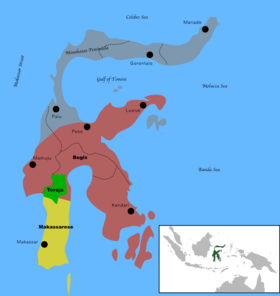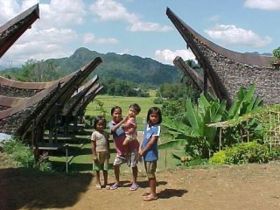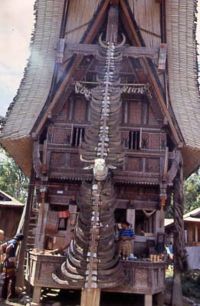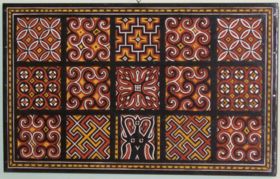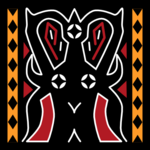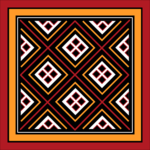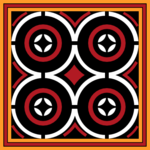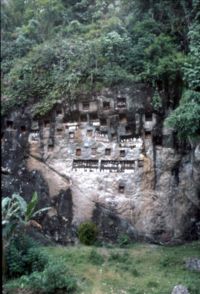Toraja
2007 Schools Wikipedia Selection. Related subjects: Peoples
| Toraja | |
|---|---|
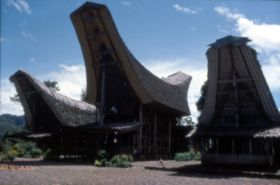 |
|
| Total population | 650,000 |
| Regions with significant populations | West Sulawesi, South Sulawesi |
| Language | Toraja-Sa'dan (no writing, belong to Austronesian family) |
| Religion | Protestant: 65.15%, Catholic: 16.97%, Islam: 5.99% and Torajan Hindu (Aluk To Dolo): 5.99%. |
| Related ethnic groups | Bugis, Makassarese |
The Toraja (or Torajans) are an ethnic group indigenous to a mountainous region of South Sulawesi, Indonesia. The population is approximately 650,000, of which 450,000 still live in Tana Toraja (or the land of Toraja) Regency. The majority of the population is Christian, with Muslim and local animist beliefs, called aluk (the way), as minorities. The Indonesian government has recognized this animist belief as Aluk To Dolo (or the way of ancestors).
The word toraja comes from the Bugis language: to ri aja means "people of the uplands" or "people up river". It also comes from the Makassarese language: to and raja, meaning "people up north". The Dutch colonial government named the people Toraja in 1909. Torajans are famous for their elaborate funeral rites, burial sites carved into rocky cliffs, massive peaked-roof traditional houses known as tongkonan, and colorful wood carvings. Torajan funeral rites are major social events, usually attended by hundreds of people and last for several days.
Prior to the 20th century, Torajans lived in autonomous villages practising animism, relatively untouched by the outside world. Dutch missionaries began working to convert Toraja highlanders to Christianity in the early 1900s. When Tana Toraja was further opened to the outside world in the 1970s, Toraja became an icon of tourism in Indonesia, exploited by tourism developers and studied by many anthropologists. By the 1990s, when tourism was at its peak, Toraja socioculture had evolved significantly from an agricultural society, in which social life and habits were outgrowths of aluk to dolo, into a largely Christianized society in which tourism is an important factor.
History
Dr. C. Cruyt, an anthropologists, has investigated that the origin of Torajans is Tongkin Bay, in mainland China. There have been a long acculturation process of local Malay people in Sulawesi with this Chinese immigrants. At first, the immigrants lived on the island's shore, near Enrekang Bay, and then they moved upland. The Bugis and Makassarese, who constitute a majority of lowland southern Sulawesi people, referred only as "to ri aja" (people upland) or "to raja" (people up north) for the Torajans.
Since the 17th century, the Dutch has established trade and political control on Sulawesi through the Dutch East Indies Company. Over 2 centuries, they ignored this upland people due to their inaccessibility and the unproductive agricultural prospects of their mountainous area. In the late 19th century, the Dutch became increasingly concerned about the spread of Islam in South Sulawesi, especially among Makassarese people. They saw the animist highlanders as a pool of potential Christians. In 1909, the Association of Dutch Reformed Missionaries (GZB) began missionary work by the help of the Dutch colonial government. Besides introducing Christianity, the Dutch abolished slavery, who is one of the Torajan social class (see Society section below), and applied local taxes. A line was drawn around Sa'dan area and called it as Tana Toraja (or the land of Toraja). Here the name of Toraja was born. The name was not taken from the Torajan language itself, but rather from the outsider view. Tana Toraja was first a subdivision of the state of Bugis, Luwu, because Bugis claimed that area. In 1946, the Dutch granted Tana Toraja as a regentschap.
Early Dutch missionaries has faced strong opposition, especially among the elite Torajans. The abolishment of slavery angered them, as they could not profit from the slave trade anymore. Many Torajan nobles were jailed or killed by the Dutch because they refused to obey the colonial authority. Some of the Torajans were forcibly relocated to the lowland by the Dutch, where they could be easily controlled. Taxes were kept high, jeopardizing the wealth of the elites. Ultimately, the Dutch failed to subdue Torajan's culture and only a few Torajans were converted.
In the 1930s, Muslim lowlanders attacked the Torajans, resulting in widespread Christian conversion among those who sought to align themselves with the Dutch for political protection and to form a movement against the Bugis and Makassarese Muslims. After Indonesian independence (1951-1965), South Sulawesi faced a separatist movement ( Darul Islam) aimed at making an Islamic state of Sulawesi. Darul Islam has killed 10,000 people, including Christians and aluk Torajans. In this period, massive conversions to Christianity took place. Following the fall of Indonesian Communist Party in 1965, more and more Torajans were converted to either Christianity or Islam, because of the massacre of any people considered atheist, including animists.
Yet, alignment with the Indonesian government itself did not always guarantee safety for the Torajans. In 1965, a Presidential Decree was introduced that required every citizen to belong to one of the six official religions: Islam, Christianity ( Protestantism, Catholicism), Hinduism, Buddhism, or Confucianism. Torajans, who still hold their original belief (aluk), are not officially recognized and they protested against this law. In an agreement to make aluk in concordance with the law, aluk had to accept as part of the one official religions. In 1969, Aluk To Dolo (the law of ancestors) was legalized as a sect of Agama Hindu Dharma, the official name of Hinduism in Indonesia.
Society
Three types of affiliation exist in Torajan society: family, class and religion.
Family affiliation
The family is the primary social and political grouping, as each village was one extended family. The family seat in each village is the tongkonan, a traditional Toraja house. Each tongkonan has its own name and this becomes the name of the village. The familial dons maintain village unity. Intermarriage between cousins is common in order to maintain a strong kinship community. Even children's names are given based on kinship. Children are named after dead relatives. Thus aunts, uncles and cousins are commonly referred to in the names of mothers, fathers and siblings. Strong kinship is actively reciprocal, meaning the extended family helps each other farm, share buffalo rituals, and pay off debts. Children inherit household affiliation from both their mother and their father, including land and family debts.
Each Torajan village was autonomous in terms of authority. In a more complex situation, in which one Toraja family could not handle their problems alone, several villages formed a group. Some villages united against other villages for different reasons. For example, several sided with the Dutch against the lowlanders. Others fought the Dutch. Traditional animists and Christian Torajans sometimes united against Muslims. At other times, all Torajans (including Muslims) united against the Bugis people.
Class affiliation
In early Torajan society, family relationships were tied closely to social class. There were three strata: nobles, commoners, and slaves, although the latter was abolished in 1909 by the Dutch East Indies government. Class was inherited through the mother. Therefore it was a strong taboo to marry "down" with a woman from lower class. On the other hand, marrying a woman from a higher class could improve the status of the next generation.
The nobility's condescending attitude towards the commoners was present as late as the 1950s, and the nobility is still maintained for reasons of family prestige. The nobility, who are said to be direct descendants of a person (to manurun) descended from heaven, lived in tongkonans, while commoners lived in less lavish houses. Slaves lived in small huts, which must be built around their owner's tongkonan. Commoners might marry with anyone, but nobles preferred to marry in-family to maintain their status. Sometimes nobles were married with Bugis or Makassarese nobles. Commoners and slaves were prohibited from having death feasts. Despite the close kinship and status inheritance, there was a certain degree of social mobility, as marriage could change someone's status, or the status could be changed as they lost or gained wealth. Wealth is counted by the number of water buffalos that someone has. During a funeral, this "wealth" is slaughtered.
Slaves in Toraja were family's property. Sometimes Torajans decided themselves to become slaves when they had a debt, pledging to work as payment. Slaves could be possessed during wars, and slave trading was common. Slaves could buy their freedom back, but their children still inherited slave status. Slave life was the lowest, and in Sa'dan area, slaves ate dogmeat. Slaves were prohibited from wearing bronze and gold, carving their houses, eating from the same dishes as their owners, or having sex with free woman. The last crime was punishable by death.
Religion affiliation
Torajan indigenous belief is polytheistic animism, called aluk, or the law. In Torajan myth, the ancestors of Torajan people came down from heaven by using a stair. This stair was then used by the Torajan as a communication medium with Puang Matua, the Creator. The cosmos, according to aluk, is divided into the upper world, the world of man, and the underworld. At first, heaven and earth were married, then there was a darkness, a separation, and, finally, the light. Beside Puang Matua, there are also Pong Banggai di Rante (God of Earth), Indo' Ongon-Ongon (Goddess who can cause earthquake), Pong Lalondong (God of death), Indo' Belo Tumbang (Goddess of medicine), and many more.
The authority, whose words and actions should be taken both in life (agriculture) and death ( funerals), is called to minaa (an aluk priest). Aluk is not just a belief system; it is a combination of law, religion, and habit. Aluk governs social life, agricultural practices, dealing with ancestral, rituals, etc. Details of aluk may vary from one village to another. One common law is the requirement that death and life rituals must be separated. The Torajan believe that performing death rituals might ruin their corpses when it is combined with life rituals. Both death and life rituals are equally important. However, the Dutch, through their Christian missionaries, prohibited Torajan Christians from attending or performing life rituals, while allowing them to perform death rituals. As a result, Torajan death rituals are still practiced until today, while life rituals diminished.
Culture
Tongkonan
Tongkonan is the traditional Torajan house, a family house made by bamboo with a distinguished boat-shaped roof. The word tongkonan is from the Torajan language's tongkon, or to sit. The construction of tongkonan is a laborious work and it is usually built with the help of all family members. In the original Toraja society, only nobles had the right to build tongkonan. Commoners live in less decorated homes ( bamboo shacks), called banua.
According to the Torajan myth, the first tongkonan house was built in heaven by Puang Matua, the Creator. It was built on four poles and the roof was made of Indian cloth. When the first Torajan ancestor descended to earth, he imitated the heavenly house and held a big ceremony. The distinguished boat-shaped roof represents prayer to the sky, where heaven is located. The outside wall of tongkonan is decorated by red, black, and yellow colored wood, with patterns carved into it.
There are three types of tongkonan. Tongkonan layuk is the house of the highest authority and it is used as the centre of government. The second type is tongkonan pekamberan, which belongs to the family group members, who have some authorities in local traditions (known as adat). The last one is tongkonan batu, which belongs to the ordinary family members.
Wood carvings
The Torajan language is only spoken; no writing system exists. To express social and religious concepts, Torajans carve wood, calling it Pa'ssura (or the writing). The carvings' motifs are usually taken from animals and plants, and they are symbols of some goodwill. For example, water plants and animals, such as crabs, tadpoles and water weeds, symbolize fertility.
The left image shows an example of Torajan wood carving, consisting of 15 square panels. The centre bottom panel represents buffalo or wealth, because they wish a lot of buffalos for their family. The centre panel represents a knot and a box. It is a hope that all of their offspring will be happy and live in harmony, just like goods that are kept safe in a box. The top left and top right squares represent an aquatic animal, which moves on the water surface, indicating the need for hard and fast work to obtain good results, and sometimes fertility. It also represents the need for a certain skill to produce good results.
Regularity and order are common features in Torajan wood carving (see table below), as well as abstracts and geometrical designs. Nature, that is used as the basis of Torajan ornaments, is full of abstractions and geometries, but there are regularities and ordering inside. The Torajan ornaments have been studied in ethnomathematics to reveal its mathematical structure, but Torajans make these arts only based on some approximations. To create an ornament, bamboo sticks are used as a geometrical tool.
| Some Torajan patterns | |||
|---|---|---|---|
| Images above were rasterized from Sande (1989). | |||
Funeral rite
In Torajan society, funeral ritual is the most elaborate and expensive event. The richer and more powerful an individual, the more expensive his or her funeral. In the aluk religion, only nobles who have the right to have an extensive death feast. However, today, as many Torajans have migrated to work in many oilwells in Kalimantan, there are many funeral rites, performed for rich commoner persons.
Often the death feast and burial are held years after the actual death, because the deceased family has to raise significant funds to cover the funeral expenses. Traditionally, the Torajan believe that death is not a sudden abrupt event, but rather a gradual process toward Puya (the land of souls) or the afterlife. Embalming is usually performed by formalin injection. The corpse is kept in the house or the tongkonan until the funeral ritual.
The death feast of a nobleman is usually attended by thousands of people and lasts for several days. The most noticeable component in the ritual is buffalos. The more powerful the person who died, the more buffalos are slaughtered at their death feast. Buffalo carcasses, including their heads, are usually lined on a field, waiting for their owner who is in the sleeping stage. The Torajan believe that a person who has died will need to make a journey, and they will be carried by the buffalos he or she had in life.
There are three methods of burial of a Torajan people. The coffin, including any possessions which will be needed in the afterlife, will be either put in a cave grave, a stone grave, or hung on a cliff. The wealthy are often buried in a stone grave, carved out of the rocky cliff, which usually costs a lot of money and takes some months to complete. In some places, the stone cave is enough to accommodate the whole family. A wooden carved effigy, called tau tau, is usually put in the cave and faced down over the land. Unfortunately, these tau tau have been targeted by grave robbers for antique collectors. One unique type of burial is to hang the coffin by ropes on a cliff face. This hanging grave usually lasts for some years, until the ropes rot and the coffin falls to the ground below. Coffins of babies and children are hung from trees.
Language
The ethnic Torajan language is dominant in Tana Toraja, although the national Indonesian language is also spoken in the community. All elementary schools in Tana Toraja teach Torajan language. There are many denominations of the language: Kalumpang, Mamasa, Tae' , Talondo' , Toala' , and Toraja-Sa'dan. All of them belong to the Malayo-Polynesian language from the Austronesian family. Each denomination has its own dialects, as seen in the table below.
| Denominations | ISO 639-3 | Population (as of) | Dialects | ||
|---|---|---|---|---|---|
| Kalumpang | kli | 12,000 (1991) | Karataun, Mablei, Mangki (E'da), Bone Hau (Ta'da). | ||
| Mamasa | mqj | 100,000 (1991) | Northern Mamasa, Central Mamasa, Pattae' (Southern Mamasa, Patta' Binuang, Binuang, Tae', Binuang-Paki-Batetanga-Anteapi) | ||
| Ta'e | rob | 250,000 (1992) | Rongkong, Northeast Luwu, South Luwu, Bua. | ||
| Talondo' | tln | 500 (1986) | |||
| Toala' | tlz | 30,000 (1983) | Toala', Palili'. | ||
| Torajan-Sa'dan | sda | 500,000 (1990) | Makale (Tallulembangna), Rantepao (Kesu'), Toraja Barat (West Toraja, Mappa-Pana). | ||
| Source: Gordon (2005). | |||||
Dialects in Torajan languages have been affected by influences from other languages. For example, Rongkong and Bua dialects of Tae' language are a product of mixing Bugis, Tae' and Java languages. This was caused by the transmigration program that was proposed in the colonialism era by the Dutch East Indies.
Economy
During the Dutch colonial period (1909-1946), Torajan economy was based on agriculture with cultivated wet rice in terraced fiords on mountain slopes, and other supplemental crops, such as cassava and maize. Livestocks of water buffalos, pigs, and chickens were also produced, mainly for ceremonial sacrifices and consumption. This agricultural based economy was maintained until the New Order era that started in 1965.
During the New Order era, Soeharto, the president of Indonesia at that time, developed and expanded foreign investments in Indonesia. Multinational corporations of oil and mining companies (gold, coal, steel, copper, etc.) opened new mining sites in Indonesia, including on mineral-rich Kalimantan island. These corporations needed highly motivated, educated and underemployed labor workers. Being close to Kalimantan, young Torajans were directly attracted to work at these foreign companies. This created a large number of out-migrations that had affected Torajan economy. When Tana Toraja was opened for tourism in 1984, economy in Toraja gradually shifted to the tourism industry. In the 1980s and 1990s, especially, many Torajans depended on their income from tourism, by working in hotels, as tour guides or selling souvenirs. However, most young Torajans are still attracted to work in mining or oil companies, as their income is bigger and they can even support their families in Tana Toraja. With the rise of political and economic instability in Indonesia in the late 1990s and early 2000s, as well as recent inter-religious conflicts elsewhere on Sulawesi, tourism to Tana Toraja has plunged in recent years.
Commercialization
Before the 1970s, Toraja was virtually unknown to Western tourism. In 1971, about fifty Europeans visited Tana Toraja. In 1972, at least 400 visitors attended a funeral ritual of Puang of Sangalla, the highest-ranking nobleman in Tana Toraja, which was documented by a British film crew and then televised in several European countries. In 1976, about 12,000 tourists may have visited the regency and in 1981, Toraja sculpture was exhibited in major North American museums. "The land of the heavenly kings of Tana Toraja", as written in the exhibition brochure, embraced the outside word.
In 1984, the Ministry of Tourism of Indonesia declared Tana Toraja Regency the prima donna of South Sulawesi. Tana Toraja was then heralded as "the second stop after Bali". Tourism was increasing dramatically. In 1985, the number of foreign visitors have increased to 150,000, excluding 80,000 domestic tourists. By 1987, tourists to Tana Toraja numbered 179,948 annually. Souvenir stands showed up in Rantepao and at the most visited tourist sites, roads were paved, and new hotels and tourist-oriented restaurants were opened. An airstrip was opened in the regency in 1981. Finally, by the mid 1990s, some tourists were starting to feel that Toraja was too commercialized.
In 1985 the South Sulawesi provincial government provincial government recognized eighteen Toraja villages and burial sites as traditional tourist objects. With this came the introduction of zoning restrictions for these sites such that Torajans themselves were barred from changing their tongkonans and burial sites. This plan was opposed by some Torajan leaders, as they felt their rituals and traditions were being determined by outsiders (tourism developers). As a result, in 1987, the Torajan village Kété Kesú and several other designated "tourist objects" closed their doors to tourists. This closure did not last more than a few days, as the villagers felt it was too difficult to survive without the income from selling souvenirs.
Tourism has played a major role in the sociocultural evolution of Torajan society. In the original Torajan society, there was a ritual which allowed commoners to marry nobles (puang) and gain nobility for their children. However, tourist imageries have changed such that Torajans are covering up their social status. High social status is not as esteemed in Tana Toraja as it once before. Many low ranking citizens can gain enough wealth by working outside the region, and then marrying a noble woman to declare themselves, and their children, nobles.
